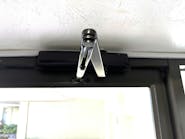The commercial entrance opening has evolved significantly over the years, prompting manufacturers to innovate in response to new demands. Commercial doors come in a range of types — swinging, sliding, folding, rolling — and materials, including hollow metal, wood, aluminum and glass. To secure these diverse openings, a broad range of locking devices and electronics have been developed, from traditional locksets and electric strikes to maglocks and other high-security electromechanical systems and advanced electronic access control solutions.
To ensure a safe interior environment, multiple layers of security are essential. These layers start at the perimeter, including gates and fences, and extend to the building's exterior where robust entry points provide the first line of defense. A secure vestibule or reception area acts as a critical checkpoint, controlling and monitoring access before allowing entry into the building’s interior office areas. This added layer ensures that only authorized individuals can pass through, effectively managing the flow of traffic and preventing unauthorized access to sensitive spaces. For areas requiring even higher levels of protection, such as record storage or server rooms, additional security measures are implemented, ensuring comprehensive safeguarding throughout the facility.
Progress in door security
One of the most significant transformations in commercial door access control has been the shift from traditional electromechanical systems to wireless and integrated electronic solutions. While these systems were historically standalone or offline, they are now increasingly part of larger, networked solutions that connect with other physical security components throughout the premises.
From electric strikes and maglocks to electrified mortise locks to electrified and online wireless products, access control solutions have evolved into highly sophisticated systems that securely communicate, passing data and credentials seamlessly. Electronic access control now connects to software platforms and the cloud, enabling real-time dynamic updates that can grant or revoke access instantly. These systems also offer comprehensive health and status monitoring, ensuring that every opening remains secure and fully operational. The result is a highly reliable, always-on solution that provides complete control over entrance security.
As commercial doors evolve, the demand for security, reliability and durability remains paramount. To meet these needs, industry standards, such as those set by Builders Hardware Manufacturers Association (BHMA), establish rigorous benchmarks for Grade 1 hardware, which is engineered for high-traffic, high-use environments. This hardware excels in providing top-tier security and long-lasting performance. Savvy manufacturers often go beyond these standards, anticipating future requirements and delivering premium products that offer not just enhanced security but also valuable data insights. These advanced electronic locking devices meet the modern demands for easy access and reliability, ensuring that commercial facilities are well-equipped for both current and future challenges.
Easier installations – even on glass
Historically, all-glass openings have been considered expensive and complicated to secure. Adding hardware or electrification has been difficult and time-intensive. But as these openings continue to gain popularity with architects and specifiers and aesthetics become increasingly important, innovation is focused on addressing and simplifying the installation challenges faced by installers.
Manufacturers have been targeting ways to make it easier to deploy door locking solutions in both design and mechanics. For example, HES electric strikes, a mainstay of protected openings, offer surface-mounted styles that present a low profile and simple installation within the existing mechanical prep, allowing for fast and easy installation without cutting or drilling the frame. Integrated adjustability and adaptable voltage sensing technology allow an installer or integrator to adapt to even the most challenging installations on the fly, completing projects with minimal traffic disruption and translating to significant time and labor savings.
Smart power at the door
Power supplies are the heart of every wired access control system. Conventional systems only provided limited information and were not readily accessible for viewing diagnostics until it was too late to proactively address an issue. Fast forward to today and they have evolved into increasingly intelligent devices that can be networked and interfaced with leading access control software platforms for real-time information. These devices gather extensive data points to maximize system uptime and reliability.
For example, networked power supplies act as a communication interface for remote power monitoring, reporting and control, collecting and delivering data that can be used to identify an ailing lock or opening with erratic or inconsistent voltage. Managed power systems can be used for powering and monitoring locks, cameras or other critical devices. Both can be used to identify the need for service before a component fails so users can get ahead of any potential issues before any downtime occurs.
Overall power usage in commercial openings has also been addressed as managed power systems now have a way to quantify a building’s energy footprint, which ishelpful to meet market demand as end-users increasingly seek green building solutions and eco-friendly security device hardware options. As an example: Maglocks can now throttle down power usage, sipping power as necessary for energy efficiency and resulting in reduced power consumption.
The commercial door has changed dramatically over the years, and as a result, manufacturers now provide a host of different profiles and devices designed to provide a secure opening and intelligent data for a safer premises overall.

Benjamin Williams | Senior Director for ASSA ABLOY’s Electromechanical Solutions Group
Benjamin Williams is the Senior Director for ASSA ABLOY’s Electromechanical Solutions Group in Phoenix, Arizona. He is responsible for identifying and defining trends for product applications, serving the HES, Securitron, Adams Rite, Alarm Controls, and LifeSafety Power brands.





